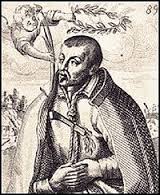 Born around 1561, Robert Southwell was a Catholic priest who wrote poetry and was one of the Forty Martyrs of England and Wales who were arrested, tortured and put to death by the state. Brought up amidst the Norfolk gentry of the time, Southwell enjoyed a privileged beginning to life, despite his family having Catholic sympathies.
Born around 1561, Robert Southwell was a Catholic priest who wrote poetry and was one of the Forty Martyrs of England and Wales who were arrested, tortured and put to death by the state. Brought up amidst the Norfolk gentry of the time, Southwell enjoyed a privileged beginning to life, despite his family having Catholic sympathies.
In 1576, Southwell went to Northern France and the region of Douai where he attended the Jesuit College at Anchin. There he met religious luminaries such as Danish moral theologian Leonardus Lessius. With French and Spanish armies moving around the region, Southwell’s religious education was interrupted for a while and he was sent to Paris for safety. Here he was taught for a while by English Jesuit Thomas Darbyshire before returning to Douai in the summer of 1577.
Southwell undertook a two year period of training to join the Society of Jesus in Rome, entering the House of Saint Andrea in 1578. When he had finished as a novitiate, he returned to his education, undertaking studies in philosophy and theology at Rome’s Jesuit College. Working as a rector’s secretary, he completed his BA and, unusual for one so young at the time, was ordained as a priest in 1584.
These were difficult times for Catholic priests in England, as a law had just been passed by Queen Elizabeth’s government that anyone who had undertaken orders with the Catholic Church was not able to stay in the country for more than forty days. The penalty for going against this act was death. Despite this, Southwell asked to be sent to England and in 1586 his request was granted.

Much of Southwell’s written work circulated in pamphlet form and was not formally published until after his death. These included tracts such as Epistle of Comfort and A Short Rule of Good Life. Throughout the 17th Century, his collections such as St Peter’s Complaint and Other Poems went through several printings and proved popular with the public at large.
In England, Southwell moved from family to family, aware that several other Catholic priests such as William Weston had already been arrested. Southwell was not alone, carrying on his mission with the help of Henry Garnet, and they were joined by two more priests once they had landed safely on English shores. Settling in London, Southwell was long suspected of being a Catholic priest but it wasn’t until 7 years later that he was actually arrested. During that time, he wrote several pieces although his name was never officially attached to them.
When he was arrested by the Queen’s priest hunter and torturer Richard Topcliffe, Southwell was subjected to 40 hours of interrogation before he was ordered moved to Gatehouse Prison. He would remain in confinement in the Tower of London for almost three years while his fate was decided.

In 1595 he was charged with treason and sent for trial, where Southwell admitted that he had been a Catholic priest staying in England but that he had never entertained thoughts of overthrowing the court of Queen Elizabeth.
The jury returned a guilty verdict and Southwell was sentenced to death. He was taken to Tyburn and, on 21st February 1595 he was hung, drawn and quartered before a large crowd.

